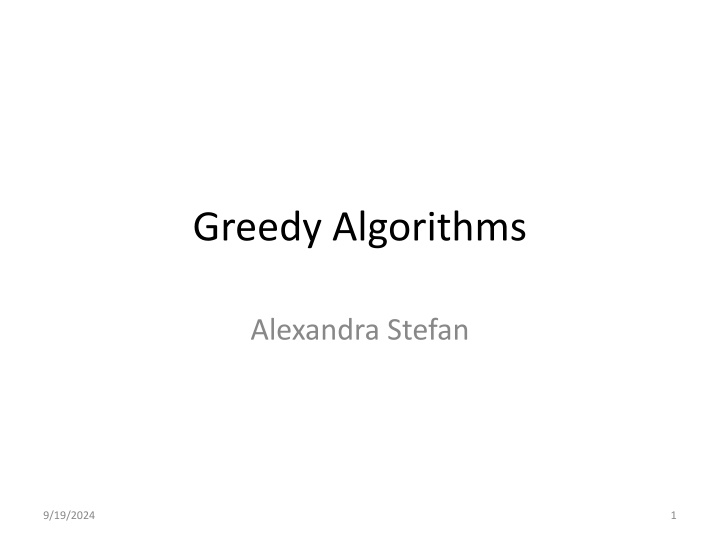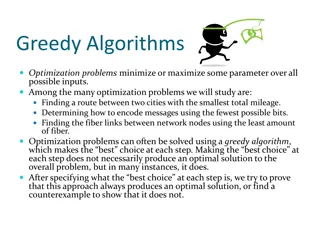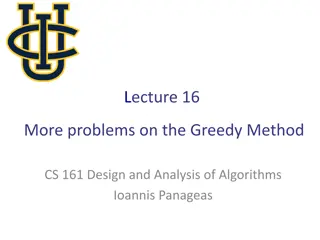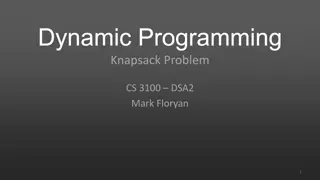Greedy Algorithms and Optimization Problems Overview
A comprehensive overview of greedy algorithms and optimization problems, covering topics such as the knapsack problem, job scheduling, and Huffman coding. Greedy methods for optimization problems are discussed, along with variations of the knapsack problem and key strategies for solving these problems effectively.
Download Presentation

Please find below an Image/Link to download the presentation.
The content on the website is provided AS IS for your information and personal use only. It may not be sold, licensed, or shared on other websites without obtaining consent from the author.If you encounter any issues during the download, it is possible that the publisher has removed the file from their server.
You are allowed to download the files provided on this website for personal or commercial use, subject to the condition that they are used lawfully. All files are the property of their respective owners.
The content on the website is provided AS IS for your information and personal use only. It may not be sold, licensed, or shared on other websites without obtaining consent from the author.
E N D
Presentation Transcript
Greedy Algorithms Alexandra Stefan 9/19/2024 1
Optimization Problems Hufmann coding File compression: encode symbols in a text file s.t. the file has the smallest size possible. Knapsack problem: Thief in a store has a backpack. Can only steal as much as fits in his backpack. What objects should he pick to make the most money? Given data: W-knapsack capacity, N number of different types of items; value and weight (vi,wi) of each item. Versions see next page Job Scheduling (a.k.a. Interval Scheduling) Given N jobs with (start_time, end_time, value) pick a set of jobs that do not overlap and give the most money. Variation: all jobs have the same value 2
Greedy Method for Optimization Problems Optimization problem multiple possible solutions, want to pick the one that gives the most value (or lowest cost) Greedy: Method: Pick a criterion that reflects the measure you are optimizing for (value or cost) take the action that is best now (out of the current options) according to your criterion (i.e. pick a local optimal). You commit to it, it may limit your future choices. It may cause you to miss the optimal solution You build the solution as you go. No need to backtrace it. Examples: Knapsack Pic the item with the largest value/weight ratio. Other possible measures: largest value, smallest weight. Interval scheduling Pick the interval that finishes first Huffman codes Prefix codes: no code is also a prefix of another code. Huffman tree to decode (the code for a character, x, takes you to the leaf with x) Edit distance greedy? not clear. 3
The Knapsack Problem Problem: A thief breaks into a store. The maximum total weight that he can carry is W. There are N types of items at the store. Each type ti has a value vi and a weight wi. What is the maximum total value that he can carry out? What items should he pick to obtain this maximum value? Variations based on item availability: Unlimited amounts Unbounded Knapsack Limited amounts Bounded Knapsack Only one item 0/1 Knapsack Items can be cut Continuous Knapsack (or Fractional Knapsack) Image from Wikipedia: https://en.wikipedia.org/wiki/Knapsack_problem 4
Variations of the Knapsack Problem Fractional: For each item can take the whole quantity, or a fraction of the quantity. Unbounded: Have unlimited number of each object. Can pick any object, any number of times. (Same as the stair climbing with gain.) Bounded: Have a limited number of each object. Can pick object i, at most xi times. flour soda All versions have: N number of different types of objects 0-1 (special case of Bounded): Have only one of each object. Can pick either pick object i, or not pick it. This is on the web. W the maximum capacity (kg) v1, v2, ,vN w1, w1, , wN, Value for each object. ($$) Weight of each object. (kg) The bounded version will have the amounts: c1,c2, , cN of each item. 5
Knapsack versions Specifications: 0/1 vs Unbounded (electronics warehouse) [There is also a bounded version] Only one item vs Unlimited amounts of each item. [bounded: given count of each type] Fractional (market: flour, rice, wine) vs Not fractional (laptop, TV) Can take a fraction of an item vs take the whole item or not at all. Produce 4 combinations: {0/1,unbounded} x {fractional, not fractional} On the web typically you see version: 0/1 not fractional What would a greedy thief do? Method: Sort in decreasing order of value/weight ratio. Pick as many of the largest ratio as possible. After that, try to take as many of the next ratio as possible and so on. Does NOT give an optimal solution. See next page. Would any of the above problems be solved optimally using Greedy? (Prove or give counter-example) Yes. The fractional version. 6
Greedy for Knapsack Criterion: Ratio W = 21 (Knapsack capacity: 21) Item A B C D E Value 4 5 11 14 15 Best available item now: C, weight of C: 7 Remaining space: 4 Want to use all remaining space with a fraction x of C => 0=4-x*7 => 4=7x => x = 4/7 Weight 3 4 7 8 9 Ratio 4/3= 1.3 5/4= 1.25 11/7 =1.57 14/8 =1.75 15/9 =1.67 Reordered decreasing by ratio: D, E, C, A, B Unbounded, not fractional Unbounded, fractional Picked D D A Picked D D 5/8 of D Remaining weight 13 (=21-8) 5 (=13-8) 2 (=5-3) Remaining weight 13 (=21-8) 5 (=13-8) 0 (=5-5) Value: 14+14+4 = 32 Value: 14+14+(5/8)*14 = 36.75 0/1, not fractional 0/1, fractional Picked D E A Picked D E 4/7 of C Remaining weight 13 (=21-8) 4 (=13-9) 1 (=4-3) Remaining weight 13 (=21-8) 4 (=13-9) 0 (=4-4) Value: 14+15+4 = 33 Value: 14+15+(4/7)*11 = 35.28 7
Greedy for Knapsack Criterion: Value W = 21 (Knapsack capacity: 21) Item A B C D E Value 4 5 11 14 15 Best item: E, weight of E: 9 Remaining space: 3 Want to use all remaining space with a fraction x of E => 0=3-x*9 => 3=9x=> x = 3/9 => x=1/3 Weight 3 4 7 8 9 Reordered decreasing by value: E, D, C, B, A Unbounded , not fractional Unbounded, fractional Picked E E A Picked E E 1/3 of E Remaining weight 12 (=21-9) 3 (=12-9) 0 (=3-3) Remaining weight 12 (=21-9) 3 (=12-9) 0 =3- (1/3)*9 Value: 15+15+4 = 34 Value: 15+15+(1/3)*15 = 35 0/1 , not fractional 0/1, fractional Picked E D B Picked E D 4/7 of C Remaining weight 12 (=21-9) 4 (=12-8) 0 (=4-4) Remaining weight 12 (=21-9) 4 (=12-8) 0 =4- (4/7)*7 Value: 15+14+5 = 34 8 Value: 15+14+(4/7)*11 = 35.28
Counter example used to prove that Greedy fails for Unbounded Knapsack Goal: construct an Unbounded Knapsack instance where Greedy does not give the optimal answer. Item B Item A $3 2kg Intuition: We want Greedy to pick only one item, when in fact two other items can be picked and together give a higher value: Item B: weight 2 (can fit 2), value 3 => total value 6 Item A: weight 3, value 5 => total value 5 Knapsack max weight: 4 !!! You must double-check that Greedy would pick item A => check the ratios: 5/3 > 3/2 (1.66 > 1.5). If item A had value 4, Greedy would also have picked B. $5 3kg Greedy DP $3 2kg $5 3kg $3 2kg $6 $5 Same example can be modified to work for 0/1 Knapsack: Item A: 3kg, $5 Item B: 2kg, $3 Item C: 2kg, $3 Item B Item A Item C $3 2kg $3 2kg $5 3kg Greedy DP B $3,2kg A $5 3kg $5 C $3,2kg 9 $6
Weighted Interval Scheduling (a.k.a. Job Scheduling) E.g.: (start, end, value) (6, 8, $2) (2, 5, $6) (3, 11, $5) (5, 6, $3) (1, 4, $5) (4, 7, $2) Problem: Given n jobs where each job has a start time, finish time and value, (si,fi,vi) select a subset of them that do not overlap and give the largest total value. After preprocessing: JobId (start, end) 1 (1, 4, $5 ) 2 (2, 5, $6 ) 3 (5, 6, $3 ) 4 (4, 7, $2 ) 5 (6, 8, $2 ) 6 (3, 11, $5 ) Preprocessing: Sort jobs in increasing order of their finish time and give them an ID for easy reference. 10
Interval scheduling versions General problem: Given n jobs where each job has a start time, finish time and value, (si,fi,vi) select a subset of them that do not overlap and give the largest total value. With values ( job = (start, finish, value) ): Each interval has a value. Goal: maximize sum of values of picked non-overlapping jobs. Greedy solution? Algorithm Is it optimal? Give proof or counter example. Without values (or same values) ( job = (start, end) ): Pick the largest number of non-overlapping intervals. Activity selection problem in CLRS (page 415) Greedy solution? Algorithm Is it optimal? Give proof or counter example. (CLRS proof at page 418, proof of Theorem 16.1) Example showing that Greedy with largest value does not give an optimal solution. 10$ 9$ 5 8 9$ 1 12 6 7 Greedy will pick the red job. Nothing else fits. Better (optimal): the 2 blue jobs. Which of the two versions is more general? Is one a special case (or special instance) of the other? If you have a program to solve problems of one type, can you easily use it to solve problems of the other type? Which type should the program solve (with value, or without value)? 11
Interval Scheduling Greedy Criteria Problem version: All jobs have the SAME value. => maximize number of jobs you can pick. Optimal: job that finishes first job that starts last (See book for proof is interested) NOT optimal: Shortest duration Least overlaps Earliest start time Example showing that Shortest duration Does not give an optimal solution. 5 8 1 12 6 7 Greedy will pick the red job. Nothing else fits. Better (optimal): the 2 blue jobs. 12
Huffman code Application: file compression Example from CLRS: File with 100,000 characters. Characters: a,b,c,d,e,f Frequency in thousands (e.g. the frequency of b is 13000): Goal: binary encoding that requires less memory. File size after encoding a b c d e f Frequency (thousands) 45 13 12 16 9 5 - Fix-length codeword 000 001 010 011 100 101 Variable-length codeword 0 101 100 111 1101 1100 13
Huffman codes Internal nodes contain the sum of probabilities of the leaves in that subtree. Optimal prefix codeword tree (Huffman tree) optimal encoding Fixed-length codeword tree a->0 b->101 c->100 d->111 e->1101 f->1100 Compute the number of bits needed for the whole file using each of these encodings. Number of bits in code 100,000 * 3 = 300,000 45,000*1 + 13,000 * 3 + 12,000*3 + 16,000*3 + 9,000 * 4 + 5,000 * 4 = 224,000 14 (Images from CLRS.)
Building the Huffman Tree 1. Make leaves with letters and their frequency and arrange them in increasing order of frequency. Repeat until there is only one tree: 1. Create a new tree from the two leftmost trees (with the smallest frequencies) and 2. Put it in its place (in increasing order of frequency). 3. Label left/right branches with 0/1 Encoding of char = path from root to leaf that has that char 2. Tree property: Every internal node has two children See book or lecture video for the step-by-step solution. In exam or hw, you must use this method. Make sure that you always put the smallest child node to the left. a b c d e f Frequency (thousands) 45 13 12 16 9 5 15
Glancing at implementation issues and options Good reference: https://www2.cs.duke.edu/csed/poop/huff/info/ File Compression with Huffman coding - Practical Issues Given an encoded file, how will you know when it ended? Typically files are stored by the OS in sizes that are multiples of a specific value, so even though your actual file takes 121 bits, on disk 128 bits are written and all that will be read when you open the file. You need to know that after 121 you are done. a) encode length of useful data in the file or b) need a new symbol to indicate end of file. Note that you must add this symbol (with count 1) to your set of distinct symbols used in building the Huffman tree, because you must be able to recognize it (decode it from bits into the symbol). Given an encoded file, how will you know how to decode it? The encoding tree is not standard, but it depends on the given file => Must record some information to know how to decode the file along with the file (at the beginning) => Store the Huffman tree (0- inner node, 1-leaf, after 1 read 8 bits and decode to symbol) Store enough info to regenerate the tree (e.g. char and frequency pairs). File format Decoding info Useful data Extra Build the tree efficiently Using a heap: Heaps are efficient (lgN) for finding min, removing min, inserting new item With heap: O(NlgN) With sort and reinsert (like on paper): O(N2) Using 2 sorted queues (https://en.wikipedia.org/wiki/Huffman_coding) 16
Greedy Algorithms Greedy algorithms do not always guarantee optimal solution. It depends on the problem. Difference between Greedy and Dynamic Programming: In DP typically you solve all the problems and then make your choice. In greedy, you make the greedy choice and you are left with only one problem. 17























